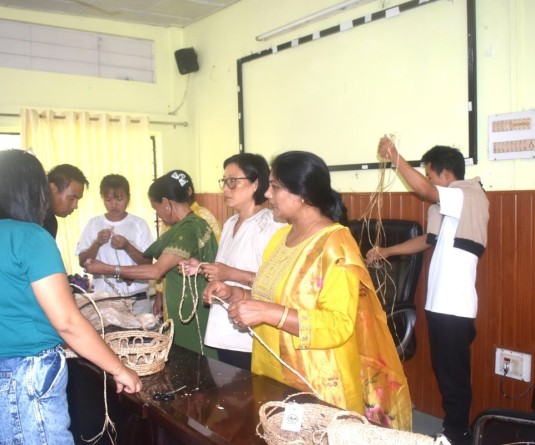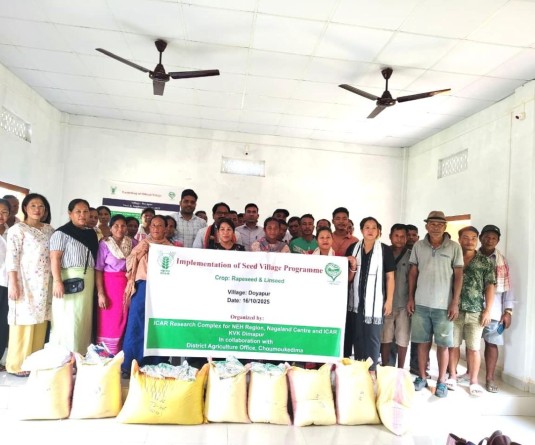
Dr. R Talimoa Mollier
Research Associate,
ICAR Research Complex for Northeast Hills Region
A sow has the capacity to yield high numbers of piglets per farrowing but it is often observed that the weaning size of the litter is grossly reduced due to low survival ability of the piglets. This is one factor which reduces the income of a breeding farmer. The low survival ability may arise from several factors:
- Inexperience and non-scientific management by the owner.
- Poor mothering quality and low milk yield by the sow.
- Poor quality piglets.
- Poor housing and adverse weather condition.
All the above factors can be dealt with through a systematic approach to the practice of pig breeding. Sows have a gestation (pregnancy) period of 114 days plus or minus 3 days. So the owner must diligently record the date of service and calculate out the due date on the calendar and get ready for the farrowing day. 12-14 days prior to farrowing the sow must be dewormed with a pregnancy safe anthelminthic. Then two days later the animal must be scrubbed clean and washed with detergent and the house disinfected thoroughly or white washed with lime. All this helps to reduce the parasitic load on the sow and also maintains a cleaner environment for the new piglets to be farrowed. The animal must be kept comfortable and insulation from cold drafts must be provided in winter. Favourably the shed must be provided with lighting. On the day of farrowing the sow will be restless, with nesting behaviour whereby she will be seen digging and rubbing her snout on the floor and her teats will ooze milk on squeezing. When such behaviour is seen it indicates farrowing within a short time. During such behaviour the sow may be given some rough gunny bags or straw in order to her sate her nesting instincts. After a while the sow will lie down with discharge of fluids and foetal faeces from the genitalia. The piglets will come out in twos and threes at intervals of about 30 minutes. If there is no expulsion of piglets but the sow is straining and the expulsion interval is getting extended, a hand may be INSERT IGNOREed into the birth canal and checked for any piglet which may be blocking the birth canal and gently retracted and removed. Upon farrowing the piglets may be cleaned from foetal membranes and kept separate from the sow in a crate or some sort of enclosure with incandescent bulbs for warmth after cutting off the umbilical cord. The umbilicus must be tied off with cotton thread 5 cm from the abdomen and cut off and disinfected with a suitable disinfectant. If the litter size is more than the number of teats available for suckling by the piglets, the piglets may be allowed to suckle in divided groups every two three hours with 30 minutes suckling time for each group. Keeping the piglets separate from the sow during non feeding periods keep the them safe from crushing by the sow. But there must be no overcrowding as the piglets may pile up on each other and suffocation mortality can occur. There is lochial discharge from the genitalia for a few days after farrowing and there is not much cause for alarm. However the owner may opt for feeding a uterine cleansing tonic to the sow if he feels so. A fly repellent spray may also be applied on the external genitalia to prevent maggot infestation. If there is low milk yield the owner may go for artificial feeding using a formula of milk powder, egg and vitamins to the piglets with a feeding bottle. The egg must be put in hot water (atleast 80°C) and stirred in order to inactivate avidin which otherwise binds biotin. This artificial feeding may be done atleast three times a day or till the hunger of the piglets is satisfied. On the fourth and fourteenth days post farrowing the piglets must be given iron injections as the sow’s milk has zero content of iron and without supplementation the piglets will suffer from piglet anemia which will result in the piglets dying from diarrhoea. Oral iron supplements are also available which are somewhat easier and safer to administer to the piglets.
The housing is also very important for survival of the piglets. The floor must be dry and kept clean. The sow and its piglets must be kept warm because there is very rapid mortality of piglets in winter from cold stress. Improved housing, deworming, iron supplementation and keeping of piglets in crates up to 7 days post farrowing reduces the early mortality of piglets by at-least 70 %. This can be followed up by timely weaning, deworming and vaccination which will help to produce higher yields in the breeder’s farm.






